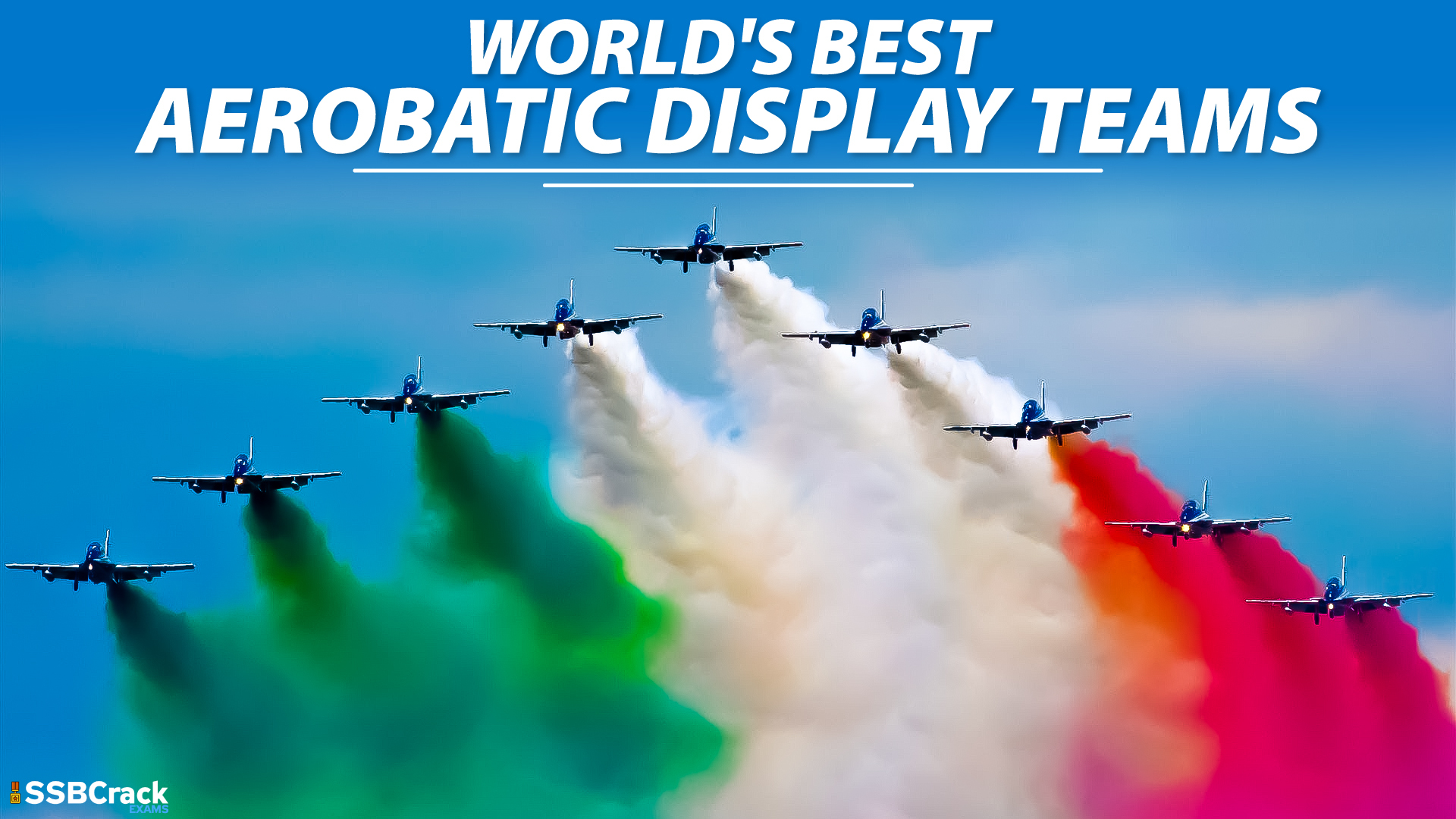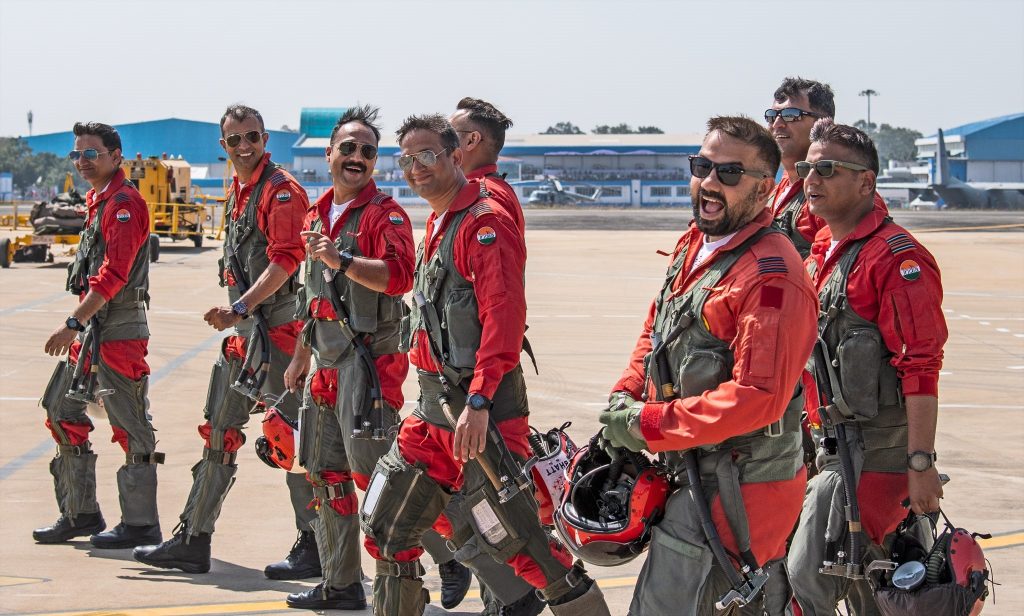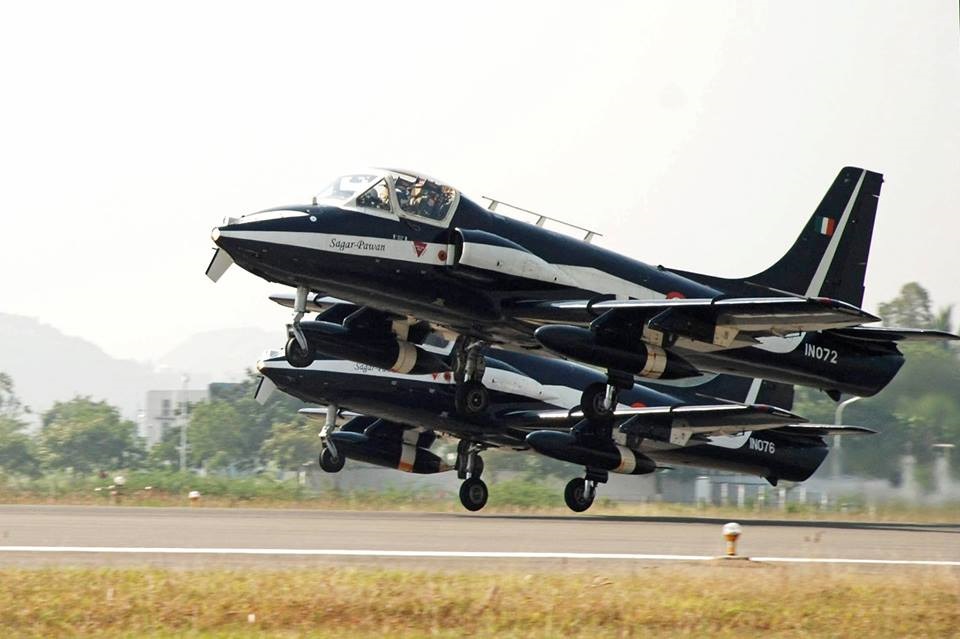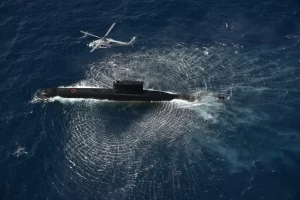We have all seen dazzling displays by the Indian Air Force during Republic Day or Air Force Day celebrations. The sight of dozens of aeroplanes , performing crazy maneuvers and lighting up the sky with colors is very beautiful.
While pilots learn aerobatics to improve their flying skills, the advent of aerobatic competitions have established it as an entertaining event. Now air forces, navies and private enthusiasts all have aerobatic teams. They compete with each other in various competitions, international or domestic. Here are the World’s best aerobatic display teams :
Frecce Tricolori
This is the aerobatic display team of the Italian Air Force. Its official name is “313° Gruppo Addestramento Acrobatico, Pattuglia Acrobatica Nazionale (PAN) Frecce Tricolori. The team started on 1st March 1961, with the intention of training pilots in aerobatics. The Italian Air Force made the team by putting together the teams from various commands under it. The squad consists of 13 Aermacchi MB339 jet trainers built in Italy, only 10 of which take part in airshows. The remaining three planes are spares.

All team members wear the call sign “Pony,” followed by the plane number of the squad. The squadron’s commanding commander pilots “Pony #0.” The Commanding Officer must be a previous team member, although he does not take part in the demos. Pony #1 is flown by the formation team leader, who must have flown with the team. The team’s only pilot flies in position #10. All candidates for the Frecce Tricolori must have at least 750 hours of flight time in a jet plane.
The support crew is made up of about 60 people who are responsible for the continuing maintenance of the team’s aircraft, as well as administration and other support responsibilities. The Frecce Tricolori’s display season begins on May 1 and consists of around 35 air demonstrations. Depending on the weather, the team has three sorts of shows: low, flat, and full. The team’s aircraft must undergo a regular service inspection every 60 flight hours. Each of the team’s aircraft is outfitted with smoke generators capable of generating green, red, and white smoke.
Red Arrows
Red Arrows is the famous aerobatic team of the British Royal Air Force. The team officially known as the Royal Air Force Aerobatic Team was established in 1964. They have obtained a prominent place in British culture and their performance is an attraction for many events in the UK.

For communication Red Arrows use call signs “Red” and the number of their team position. A squad pilot will typically serve a three-year tour of duty . Others return to the regular Air Force, some are promoted, and some quit the RAF to work as airline pilots. The Leader should have been a team member beforehand and has to earn himself the title Red 1.
The team’s technical workforce comprises around 70 technicians who are led by a senior engineering officer and assisted by a junior engineering officer. The technical team is divided into two groups: the “Traveling Team,” which is made up of approximately a third of the team’s members, the remaining two-thirds which remain at the team’s home base. When the crew is at home, the “Base Party” is in charge of all necessary rectification duties. The “Traveling Team” is in charge of the team’s day-to-day engineering responsibilities while they are touring”.
Depending on the weather, the Red Arrows put on three distinct sorts of shows. A “Full” show, a “Rolling” show, or a “Flat” show are the three options.The lowest limit of the clouds must be no lower than 1400 metres for the complete display. If the weather limit is between 760 and 1400 metres, the “Red Arrows” will only execute rolls, however the Leader will constantly be looking for an opportunity to loop. If the weather restriction is less than 760 metres, they put on a “flat show,” which is just a series of formation ‘fly-bys.’ Because of the weather, the Leader has the choice to switch from one sort of display to another at any moment.
Blue Angels
The United States Navy Flight Demonstration Squadron is known as the “Blue Angels.” They also represent the Marine Corps of the United States of America. The “Blue Angels” now operate 11 jets: nine single-seat F/A-18E Super Hornets and two two-seat F/A-18F Super Hornets. Only six are utilised during demonstration flights (usually single-seat variants), while the others are used as backups in case one of the main planes breaks down and cannot be repaired before the presentation. The squadron also has a permanently assigned cargo aircraft, a C-130 Hercules nicknamed “The Fat Albert,” which is used to ferry ground crews, replacement parts, and other items.
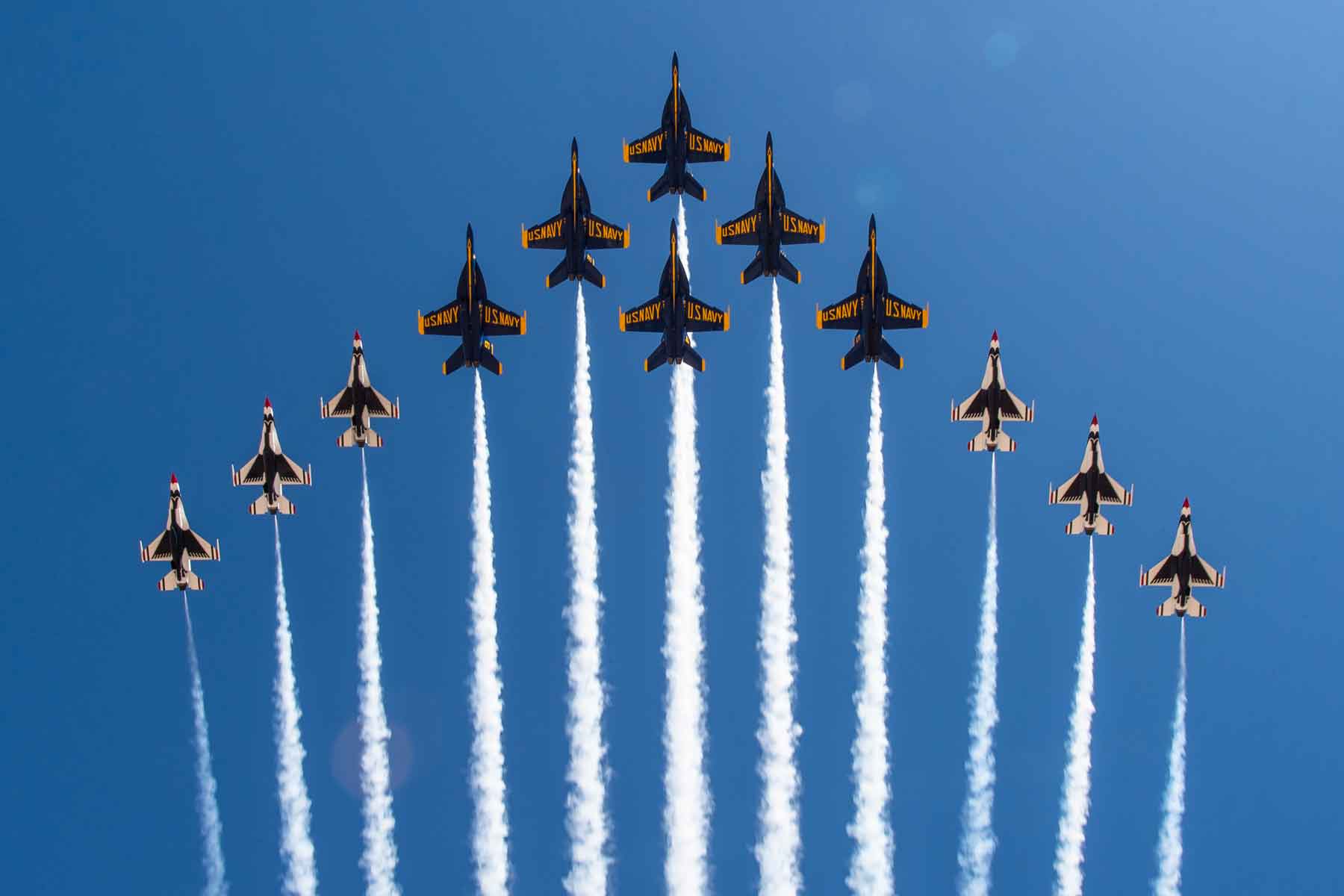
The US Navy aerobatic team consists of 126 men, 16 of which are officers and the rest are sergeants. The Chief of the Naval Center of Air Training chooses the squadron’s commander and leader. He or she must have logged at least 3000 hours in a jet fighter and have served as the leader of a naval squadron. Aircraft #1 is flown by the team leader.
The “Blue Angels” Navy Flight Exhibition Team’s show performance usually lasts around 40 minutes. A visibility of at least 5500 metres (6015 yards or 18 045 feet) from the show centre is required to execute the basic display. The “Blue Angels” will postpone the display if the lower limit of clouds is less than 450 metres (492 yards or 1476 feet). They will put on a display with a restricted number of moves, usually in a horizontal plane, if the limit is between 450 metres (492 yards or 1476 feet) and 1050 metres (1148 yards or 3445 feet) (i. e., without formation loops and rolls). This is referred to as a “flat” performance. If the lower limit is between 1050 metres (1148 yards or 3445 feet) and 2450 metres (2679 yards or 8038 feet), they do a “Low” performance, which includes barrel rolls but no loops. The “Blue Angels” may conduct their whole act if the lower limit is higher than 2450 metres (2679 yards or 8038 feet). The minimum distance between display aircraft will always be between 1 and 1.5 metres (3.3 and 1.5 feet) (5 feet).If one of the team pilots is unable to fly due to illness during the show, the remaining pilots will fly without him. The show will have to be rescheduled if the commander is unable to fly.
Surya Kiran
Surya Kiran is an Indian Air Force aerobatics display squad. It was founded in 1996 and is a member of the IAF’s 52nd Squadron. Since then, the crew has conducted several demonstrations, generally with nine planes. Until 2011, the squadron was made up of HAL HJT-16 Kiran Mk.2 military training aircraft located at Bidar Air Force Station in Karnataka. In February 2011, the team was suspended, but was re-established in 2017 using Hawk Mk-132 aircraft.
There were 13 pilots on the team, although only 9 were flying at any given moment. Pilots are chosen for a three-year term of duty twice a year. Only pilots with experience flying fighter jets are chosen. All of the team’s pilots are qualified flight instructors (QFIs) with over 2,000 hours of fighter experience and 1,000 hours on the Kiran. During show sorties, the Team is led by a Commanding Officer who also serves as the formation’s leader. After putting them through arduous flying trials and testing, the Squad Leader has the option of picking his future team pilots.The crew also included a Flight Commander, an Administrator, and certified Technical Officers in addition to the pilots. Operational planning is the responsibility of the Flight Commander. Apart from caring after the Team’s administrative needs, the Administrator also gives comments during public presentations. The Senior Engineering Officer is in charge of maintaining and servicing the Team’s aircraft, together with fifty technicians. The judgement of the Senior Engineering Officer is final in all technical matters.
The Kiran MKII plane, which had been modified for aerobatics, was used to produce parallel and horizontal flying designs, as well as famous patterns such as the heart and arrow, the water spring, and the apple. Depending on the location of the display site, the display routine might last anywhere from 10 to twenty minutes. In various nine aircraft formations, the initial part of the routine involves spins, wingovers, loops, and barrel rolls. During the second half, the formation separates into two groups to do splits, level and rolling crossings, inverted runs, the heart loop, and other manoeuvres.
Sagar Pawan
The Indian Navy’s Aviation Arm’s aerobatic demonstration squad is dubbed Sagar Pawan. The team is stationed at the Naval Air Station INS Hansa in Dabolim, Southern India, and operates four Hindustan Aeronautics HJT-16 Kiran Mk.2 training aircraft. The aeroplane has a dark blue and white colour scheme. Sagar Pawan (See Breeze), an Indian Navy aerobatic team, was created in 2003 at Dabolim Naval Air Station in Goa, Southern India, with the maiden presentation in May of that year. Dark blue and white were used to paint the planes. White, red, and blue smokes were utilised.
The Team was formerly known as Sagarkiran, and it was under this name that it performed its formal inaugural premiere show (then with only three aircraft) at Kochi, India on May 11, 2003 during the Golden Jubilee of Indian Naval Aviation. Commander Surendra Ahuja was the Team’s first leader. The Indian Naval Air Squadron 551 received a new function as a result of the creation of the Team. The squadron had attempted to create an aerobatic team in the past, but the attempts were unofficial and not sustained for long enough to acquire any meaningful formality.
To crack the AFSB and SSB interview, we recommend you to Enroll SSB INTERVIEW ONLINE COURSE. Trusted by thousands of defence aspirants
